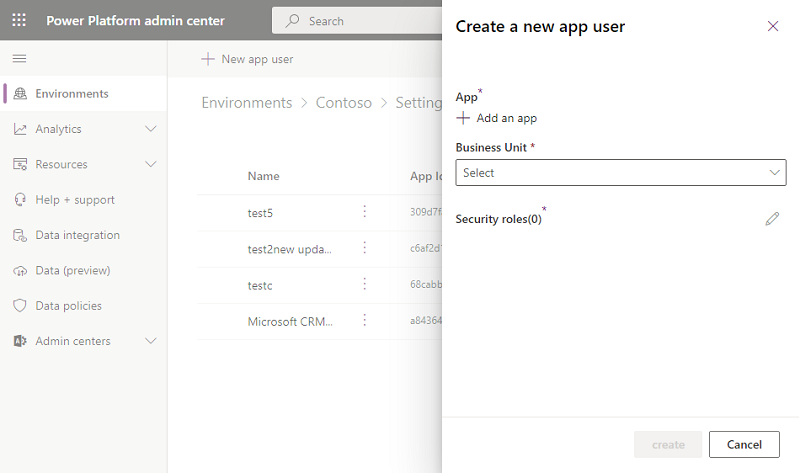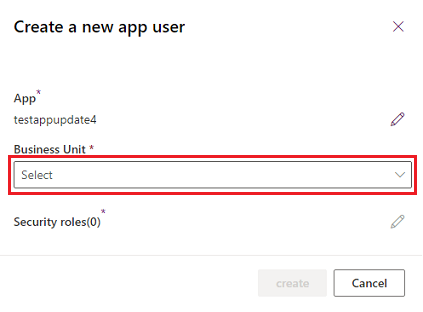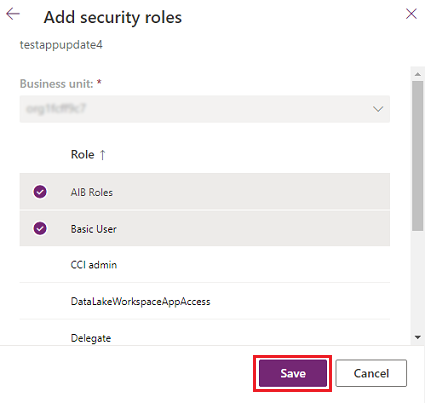Note
Access to this page requires authorization. You can try signing in or changing directories.
Access to this page requires authorization. You can try changing directories.
We're in the process of moving application user management from the legacy web client, as documented in Enable or disable application users. Follow these steps to manage application users in the Power Platform admin center.
Note
Deleting an inactive, application user is now supported.
Tip
Check out the video: Administer application users, security roles, teams, and users in the Power Platform admin center.
View application users in an environment
On the Application users page, you can view and manage application users. The Custom app type is your local app registration, as created in Microsoft Entra ID.
- Sign in to the Power Platform admin center.
- Select Manage in the navigation pane.
- In the Manage pane, select Environments. Then select an environment.
- Select Settings.
- Select Users + permissions, and then select Application users.
Create an application user
You can create an unlicensed application user in your environment. This application user is given access to your environment's data on behalf of the user who's using your application.
In an environment, you can only have one application user for each Microsoft Entra–registered application.
Sign in to the Power Platform admin center.
Select Manage in the navigation pane.
In the Manage pane, select Environments. Then select an environment.
Select Settings.
Select Users + permissions, and then select Application users.
Select + New app user to open the Create a new app user page.

Select + Add an app to choose the registered Microsoft Entra application that was created for the selected user, and then select Add.
Note
In addition to entering the Application Name or Application ID, you can also enter an Azure Managed Identity Application ID. For Managed Identity, do not enter the Managed Identity Application Name, use the Managed Identity Application ID instead.
Enterprise applications don't show in the list of applications, only Microsoft Entra app registrations show in the list. Search for the multitenant application by name or ID to assign it to the application user.
The selected Microsoft Entra app is displayed under App. You can select Edit (
 ) to choose another Microsoft Entra application. Under Business Unit, select a business unit from the dropdown list.
) to choose another Microsoft Entra application. Under Business Unit, select a business unit from the dropdown list.
After choosing a business unit, you can select
 for Security roles to choose security roles for the chosen business unit to add to the new application user. After adding security roles, select Save.
for Security roles to choose security roles for the chosen business unit to add to the new application user. After adding security roles, select Save.
Select Create.
View or edit the details of an application user
To view or edit the details of an application user, complete the following steps:
- Sign in to the Power Platform admin center.
- Select Manage in the navigation pane.
- In the Manage pane, select Environments. Then select an environment.
- Select Settings.
- Select Users + permissions, and then select Application users.
- Select an application user, and then select Details.
The Details page shows the following properties for the application user:
- Name
- Microsoft Entra application ID
- State
- Assigned security roles
- App type
- Business unit
- Email address
You can edit only the business unit, email address, and security roles properties.
Sync the application user name with the Microsoft Entra application name
When an application user is first created, the username is the same as the name of the registered Microsoft Entra application. The two names can get out of sync when the name of the Microsoft Entra application is changed. You can sync the application user name with the Microsoft Entra application name by selecting Refresh on the Details page.
Note
Refresh and the Microsoft Entra app name are only shown when the two names are out of sync.
Manage roles for an application user
In addition to using the entry point on the Details page to manage roles, you can select Edit security roles on the menu bar on the Application users page. If the application user has roles assigned already, those roles appear as selected on the page.
You can select or deselect roles, and then select Save. All selected roles become the current assigned roles for the application user. Any unselected roles aren't assigned.
Note
All your application users can run in any environments that are secured with a security group without being a member of the security group.
Activate or deactivate an application user
To activate or deactivate an application user, complete the following steps:
Go to the Application user page.
To activate an application user, select Activate on the menu bar, and then select Activate in the confirmation dialog.
To deactivate an application user, select Deactivate on the menu bar, and then select Deactivate in the confirmation dialog.
Delete an inactive, application user
To delete an inactive application user, complete the following steps:
- Go to the Application user page.
- Select an inactive application user.
- Select Delete on the command bar.
- Select Delete in the confirmation dialog.
Note
Only application users with the inactive state can be deleted. You must reassign all records owned by inactive application users before those user records can be deleted. You can add an application user back into the environment if the application user still exists in your Microsoft Entra App registrations.
View the details of system-provided application users
In each of your environments, there's a set of system-provided application users. You can now view these application users from the Power Platform admin center.
- Sign in to the Power Platform admin center.
- Select Manage in the navigation pane.
- In the Manage pane, select Environments. Then select an environment.
- Select Settings.
- Select Users + permissions, and then select Application users.
- Select the Filter option from the command bar.
- Select the Platform option. A list of the platform, application users in the environment is displayed.
- Select an application user.
- Select Details from the command bar to view details of the platform, application user.
- Select Close to return to the application user list.